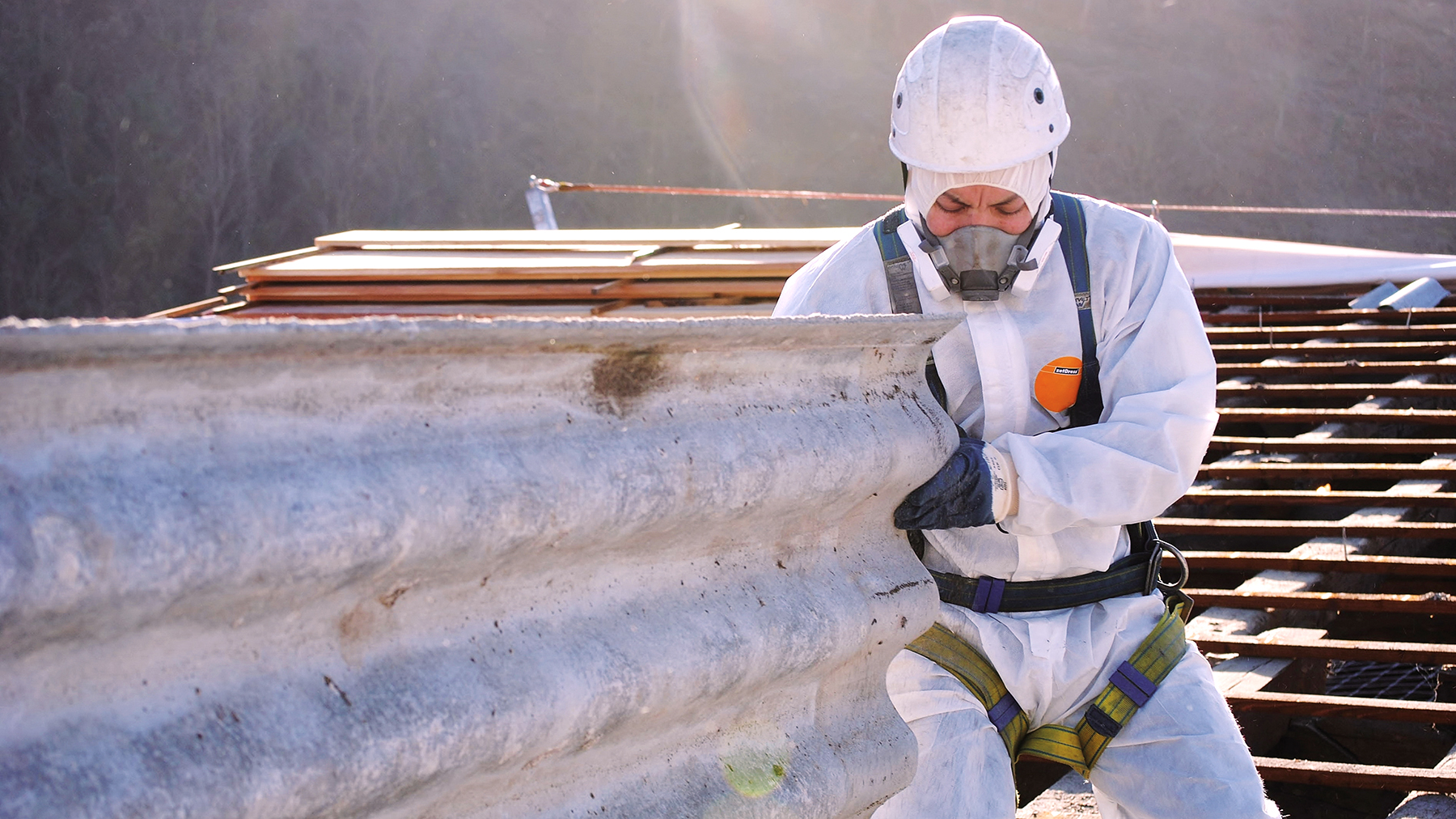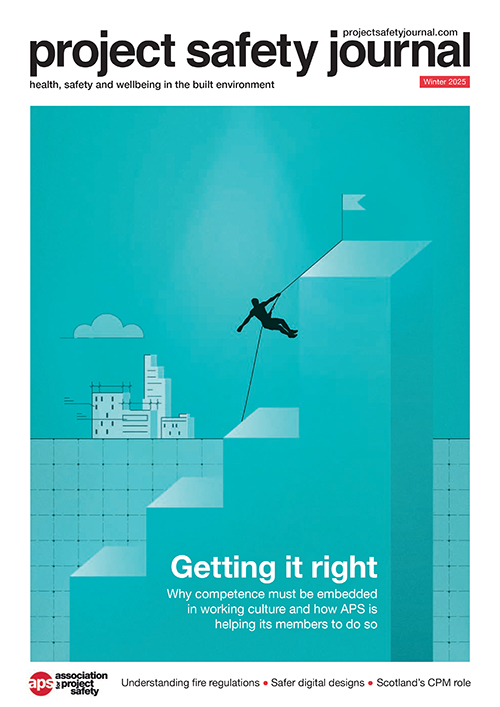
Asbestos remains the UK’s number-one workplace killer and increasing evidence of its mismanagement by dutyholders has led to calls for an overhaul of existing systems and approaches to detection, reporting and risk assessment. Stephen Cousins reports.
Just when it seemed the longstanding issue of asbestos was receding from view, another scandal hit the headlines in February when the landlord One Housing revealed serious flaws in its management of the hazardous material.
It started when a tenant in a property owned by the former 17,000-home housing association (which was fully amalgamated into Riverside in 2023) complained to the Housing Ombudsman about a leak and a collapsed ceiling, where repairs took 14 months.
An investigation found that the landlord had failed to keep up-to-date records on the presence of asbestos in the property, or to assess its condition.
One Housing was then forced by the Ombudsman to carry out its own review, which uncovered over 800 records of incorrect data on its asbestos register. Several properties were categorised as ‘no-risk’, despite a lack of data when asbestos could in fact be present, others had been marked as ‘high-risk’, where old data had not been removed.

The review concluded that data inconsistencies were the result of factors such as external services being brought in-house, poor knowledge and information management, and data being added when moving to a new system without the existing records being updated.
One Housing claims to have updated its processes to address these failings, but they are symptomatic of a wider issue with inadequate asbestos management among UK dutyholders.
HSE’s school inspection programme in 2022/23 found that 7% of schools had failed to manage asbestos effectively. That may sound like a small percentage, but when scaled up it represents a potential 2,000 schools and up to 1 million pupils, not to mention staff, exposed to risk.
Asbestos containing materials
Another recent examination of 128,000 buildings by the asbestos consulting trade associations ATaC (Asbestos Testing and Consulting) and NORAC (National Organisation of Asbestos Consultants) found a high volume of damaged asbestos containing materials (ACMs).
Of the 710,000 ACMs identified, about 71% were damaged – and of the 280,000 items listed as reinspections of previously known ACMs, 72% were damaged. According to the report, this means they were either damaged when originally found and had not been made safe, or were damaged in the intervening period – scenarios that both indicate a failure to manage asbestos risk.
Evidence of inadequate management processes is backed up by experts who point to entrenched problems with inaccurate and inconsistent surveys, out-of-date record keeping and vital information not being passed to contractors about to complete work. Perhaps most alarming of all, building owners and managers are failing to understand even basic requirements for compliance.
“It is extremely concerning that, on the whole, dutyholders don’t really understand how to manage their asbestos,” explains Colette Willoughby, director of Asbestos Compliance Ltd, and chair of NORAC. “They seem to think that if they simply employ a surveyor to do some surveys then put it into a register it’s job done, whereas that should just be the starting point.”
Toxic legacy
Although asbestos has been banned in the UK since 1999, it remains a significant public health concern, present in around 1.5 million buildings and responsible for around 5,500 deaths a year, more than three times the number of road accident deaths.
Asbestos is insidious because its near-invisible microscopic fibres remain airborne for extended periods and the diseases it causes – mesothelioma, asbestosis and lung cancer – have long latency periods so exposure decades ago can still be debilitating or fatal today.
The material can be found in workplaces, schools, hospitals and residential properties in the form of roof tiles and guttering, vinyl floor tiles, insulation around heating pipes and ducts, and textured ceilings. It poses serious health risks if disturbed, such as during demolition or refurbishment, making its effective management a top priority.

The primary legislation governing asbestos is the Control of Asbestos Regulations 2012, which under Regulation 4 set out ‘duty to manage’ requirements. These oblige owners and managers of non-domestic premises, or ‘common parts’ of multi-occupancy domestic premises, such as purpose-built flats, to take proactive steps to identify any ACMs, assess their condition, and implement a comprehensive management plan to prevent exposure.
The dutyholder must produce an asbestos survey, completed by a competent asbestos surveyor, identifying any ACMs and their location, amount and condition. The survey information is used to produce an asbestos register, a live document recording the location and condition of ACMs, and providing an assessment of exposure to risk and the actions needed to manage the risk.
Data concerns
Information in the register should form the basis for an asbestos management plan, used to manage the risks to ensure that no one is exposed, which is reviewed every 12 months as changes occur.
Effective asbestos risk management is dependent on accurate survey data, but experts report longstanding concerns about its standard and accuracy.
According to Willoughby, factors including time constraints and cost-cutting by surveying organisations competing to get on frameworks, mean these are often ineffective.
“The companies will cut things to the bone just to win the work, which usually means that things get cut when they’re on site – either the person doing the work hasn’t been given enough time, or maybe they’re just not trained well enough, so they miss things,” she says.
Guidance recommends having at least two people on a survey team, partly to ensure safety, when using ladders or entering roof spaces, but also because two sets of eyes are better than one. “Often surveying organisations only send one surveyor and things can get missed,” says Willoughby.
Varying standards of the content and terminology of survey reports can also create confusion for dutyholders. Data is often generated from a database and presented in a table with a list of products sampled, locations and material assessment scores, rather than in a format that’s easy for non-technical people to understand and retrieve information from.
“When we were preparing the ATaC/ NORAC report we had a million lines of asbestos survey data within which we found about 27 different ways to describe a floor tile,” says Jonathan Grant, managing director of Gully Howard Technical and registrar of the Faculty of Asbestos Assessment and Management (FAAM).
“HSE guidance HSG 264 sets out how to conduct asbestos surveys, but there isn’t consistency in the terminology, which needs standardisation.”
Evolving response
Surveys are done properly, evidence suggests that some property owners and managers are failing in their ‘duty to manage’ by proactively addressing asbestos risks.
The most common failings identified by the HSE’s 421 inspections of primary and secondary schools in 2022/23 were inadequate or missing asbestos management plans and asbestos management surveys.
There were cases where asbestos registers did not clearly indicate if remedial action identified during a survey has been completed and records updated. Certain schools were not regularly monitoring the condition of ACMs, and some asbestos management plans failed to include incident procedures for dealing with their unplanned disturbance.
Certain schools were not ensuring that contractors tendering for work provide risk assessments, method statements or evidence of asbestos awareness training.
The investigation resulted in two prohibition notices and 28 improvement notices, with a further 112 schools sent letters of non-compliance.
Dutyholders’ records should be maintained and updated through regular reinspections to check the condition of ACMs and if they have been removed. But, according to Paul Shaw, managing director of asbestos specialist Environtec: “All too often organisations don’t allocate resources properly to maintain this data.”
Communicating information
The way they store and share data as part of their management strategy is another concern, he adds: “You might have a lot of good survey information, but what do you do with it? If it is stuck in a drawer or in a file on your system, it’s no good to anyone, you need to make sure the information gets to the people that need to see it.”
This view is echoed by Grant, who observes: “Where things most often fall down – and this seems to apply to various organisations – is in effectively communicating the information to those who are liable to disturb the asbestos.”
Any client planning to do any construction work on a property built before 2000 must carry out intrusive refurbishment or demolition surveys and assessments beforehand to ensure any ACMs are identified and assessed to deal with the risk to
those who may be exposed.
However, anecdotal evidence suggests a worrying trend to rely instead on management asbestos surveys, which only involve minimal or no intrusion.
“Clients often either think their management information is all they need, or they commission a survey but don’t fully scope it out, so the surveyor doesn’t know the full extent of the refurbishment and doesn’t check everywhere,” says Willoughby. Clearly, if the survey isn’t relevant to the work, people may be put in danger.
With organisations still struggling to fulfil their responsibilities on asbestos over two decades after Regulation 4 was introduced, various stakeholders want to push through new measures and initiatives to improve the situation.
Phased removal
A 2022 inquiry by the House of Commons Work and Pensions Committee into the HSE’s approach to asbestos management recommended the establishment of a central register of information on asbestos in buildings, needed to expose the true level of compliance and help create “a more effective risk-based and targeted enforcement regime”.
The inquiry also said the government should move away from its preference for managing asbestos in situ, to a proactive stance of removing all asbestos from public and commercial buildings within 40 years.
Whitehall shot down these suggestions in 2023, saying there was a lack of clear evidence they would improve health outcomes. Taking advice from the HSE, it said removing asbestos could release asbestos fibres, increasing the risk of exposure.
Undeterred by the lack of movement, in 2024 a new social enterprise, Asbestos Information CIC, was launched by a group of accredited surveying organisations in partnership with ATaC and NORAC, to tackle the issue of complex asbestos survey reports and management actions.
A key outcome was the asbestos information certificate (AIC), a concise 1-2 page report designed to make asbestos management information more accessible and actionable.
Modelled on energy performance certificates (EPCs) for buildings, and created by analysing millions of lines of asbestos survey data provided by member organisations, the certificate translates the numerical risk process developed by HSE into an easy-to-follow colour-coded graph with an A-G rating for asbestos management.
Common surveying terminology
In related work, the social enterprise also created a ‘common surveying terminology’ to help eliminate inconsistencies and standardise information provided to dutyholders.
“There’s a lot of interest in the AIC, particularly because it’s not requiring people to go out and resurvey everything, it’s taking the information that’s already there and consolidating it and making it easier to digest,” says Grant, adding that where the concept of a central asbestos register has so far failed to take off, this has the potential to make a similar impact at “minimal cost”.
Digitalised technology has a role to play in improving the monitoring, management and removal of asbestos.
Construction projects are increasingly turning to BIM to improve information management, and the app NexGen, by risk management specialist Lucion Services, populates 3D models with asbestos information held in its database giving surveyors and contractors a much-needed heads up of the precise location of materials and their risk levels.
Shaw points to the potential benefits of AI for automating report production, which by pulling together data from surveys, photos, material samples and drawings, etc could generate insights and summarise the major risks.
AI-powered detection
Asbestos professionals have been experimenting with AI-powered detection systems developed to spot asbestos. One company reported that applying the deep learning model Mask R-CNN to detect asbestos in roofing resulted in a 94% precision rate.
And in an effort to tackle detection at a macroscopic level, there’s also a push in Europe to adopt electron microscopy, a technology that can identify smaller, more harmful asbestos fibres than standard phase contrast microscopy (see panel).
Mounting evidence of asbestos mismanagement has also led to calls for a clampdown by the regulator and a greater emphasis on training and competence, including mandatory accreditation for surveying organisations.
“People that are doing the surveying work are covered with qualifications, but people who manage it at any level within an organisation have no requirements for any asbestos qualifications. It’s almost just assumed that they must know what they’re doing because they’ve got that title,” says Willoughby.
In the face of widespread ignorance of asbestos requirements and a failure to implement appropriate processes and procedures to minimise risk, perhaps now is the time for the industry to act to prevent the unacceptable death toll from mounting.

Can the UK keep pace with Europe on asbestos exposure?
The European Union Council took a crucial step to safeguard workers against asbestos in 2023 by adopting a new directive that enforces stricter protections and enhances early detection of asbestos fibres.
Changes under EU Directive 2023/2668/EU, which amended the previous Directive 2009/148/EC, include a tenfold reduction of the occupational exposure limit for asbestos, reducing the previous limit of 0.1 fibres per cubic centimetre to 0.01 f/cm³.
The UK exposure limit is currently set at 0.1 f/cm³, or in certain circumstances 0.6 f/cm³ when work involves some lower-risk asbestos-containing materials.
Upping the ante even further, after the maximum transitional period of six years, EU member states will be required to implement a new electron microscopy method for measuring asbestos levels, which is more sensitive than currently phase-contrast microscopy. This means that by 2026 the exposure limit will be further reduced to 0.002 f/cm³.
There is considerable pressure on the HSE and government to consider similar reforms, especially from stakeholders advocating for the proactive removal of asbestos from all non-domestic buildings by 2040, as recommended by the Work and Pensions Committee in 2022.











